King Salmon Fishing Tutorial
Introduction
Salmon fishing from a kayak is considered by many anglers as the premier “Sport” fish in Northern California — Nothing fights, runs and breaks your heart quit like a salmon. The frequency of heart breaks is more likely on a kayak, but that doesn’t need to be the case. Along the Northern California coast King Salmon (Chinook) is the predominate species. Coho (Sliver) Salmon also inhabit the California coast line.
(Salmon Fishing Tips by The Lost Anchovy)
Best Time and Locations
King Salmon in California starts in early April (Check with DFG) as the dates sometimes change, or in some years shut down all together. In the early part of the season veteran anglers rely upon trolling to find the scattered fish from Monterey to Eureka.
As the summer progresses and bait fish moves inland the salmon become more easily targetable by Kayak fisherman. Popular Kayak fishing areas are: The Golden Gate Bridge between Duxbury Point (Bolinas Point), Half Moon Bay (Ritz Carlton, or between RED and Green Can), Monterey (Lovers Point), Muir Beach, Stinson Beach, Bodega Bay, Shelter Cove, Noyo harbor, Pt. Arena, Albion, Fort Bragg, Ocean Cove, Santa Cruz
Identification
Salmon are voracious predators. Their biology and feeding instincts is a testament to their evolutionary predominance in the ocean. Wild salmon can be identified by their dorsal fin. Hatchery salmon are missing the adipose fin.
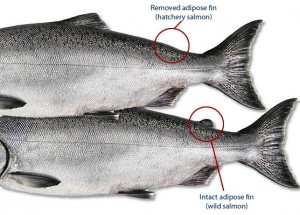
King Salmon are identified by their black gum lines, a Coho salmon has a white gum line. In California it is legal to keep King Salmon but Silvers (Coho) must be released.
Fish Finders, Depth and Bait.
Targeting salmon requires having a good fish finder that can correctly mark bait and feeding fish. Salmon are versatile fish that move up and down the water column. Unlike bottom fish like, Halibut or lingcod, identifying the correct depth and bait location is critical to being successful.
Salmon Primarily feed on:
- Krill
- Squid
- Bait fin Fish (*Anchovies, Sardines, Herring)
- Baby Rock Fish
*Anchovies are the preferred bait for salmon. Anchovies can be mooched or placed in a RSK/Cripple anchovy for trolling. Keeping a good “roll” on an anchovy is critical to getting a bite. Popular lures that work for salmon include: Watermelon Apex, Purple Haze Hoochies, various spoons and cast masters.
The Lost Anchovy – Essentials Gears List
- Shimano Trevala 7′ rod TVC70ML
- Owner No Escape Hooks 3/0
- Lowrance Hook 4 or 5 FF
- Fisherman’s Game Clip
- 25-30lb Salmon STS leaders
- Spro 130lb swivel
- Dexter Russel Fillet Knife (Best fillet knife IMHO, cheap and works!)
- Big Al Flashers
- Deep Six Divers
- Scotty_Downrigger
Kayak Fishing Salmon Techniques
Mooching
Mooching is fishing style where a fisherman keep the dead bait suspended around a bait ball. (Above or Below). The object of mooching is to drift a live or dead bait across a school of bait fish in pursuit of a salmon. Salmon attack bait around the perimeter of bait balls. They will stun the bait then come around to swallow it whole. They are actively looking for damaged or stun bait to eat around the perimeter. Mooching mimics damaged bait and is an extremely effective method of fishing when bait is concentrated and causing the salmon to school up around them.
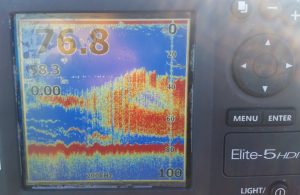
TIP: When mooching make sure to pay special attention to the line. If the line goes slack before hitting bottom chances are it has been hit by a salmon. Reel the line in as fast as possible to set the circle hook and keep tension on the line at all times.
- Salmon unlike other species will “RUN at you” ,or jump making the line go slack. This does not necessarily mean the fish has come off the hook –keep reeling!!! chances are the fish is still on the line.
- Circle hooks are different from”J”or other hooks. Setting the hook “Bass Pro Style” will pull the hook out of the salmons mouth. To properly set the hook, lift the rod out of the holder and reel in the line. The reeling action will automatically engage the circle hook leading to a proper hook set, typically on the corner of the mouth or on the bottom lip.
When mooching it is important to keep the bait moving. This can be done by slowly releasing line with small pulls or reeling up slowly in the strike zone. An important part of salmon mooching is “pumping” the rod every so often. Releasing and reeling line will make the bait look like it is “leafing”, meaning falling back and forth like a leaf. This action mimics bait that has been stunned and falling which leads to increase strikes.
Finding the Fish
There is an old saying from veteran fisherman. “Find the bait, and find the Fish” It is simple enough but that is the truth. Finding bait is critical to this fishery. Look for environmental cues that will point out where the fish are.
Diving birds and whales
Fish near the diving birds and feeding whales. The birds are looking for an easy meal when the anchovies are driven to the surface. Anchovies are driven to the surface by….wait for it…SALMON!!! Mooch or Trooch around the bait ball and get a fish. –Simple as that.
Whales are are usually a sign that salmon are near. Charter boats, sport fisherman and kayakers are usually hanging around them. My theory is the whales will gorge on the large school of anchovies and break them up. The salmon will charge in and take advantage of the confusion and scattered bait, looking for an easy meal. Fishing around feeding whales is always a good bet.( TLA tip)
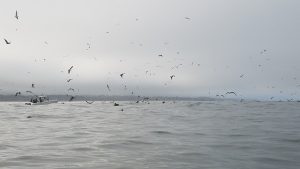
Diving_Birds attacking bait
Trolling
Trolling for salmon is effective in the early season because the bait is not concentrated in any particular location and the fish are scattered. When trolling for salmon it is important to keep the bait presented well and in good condition. Trolling can be done with lures (spoons and apexs) or with bait (FBR, Cripple Anchovies). Make sure the bait is spinning properly. A proper spinning bait will entice the predatory instincts of a salmon leading to more consistent bites.
Many Anglers use Flashers in front of their brined bait to attract Salmon. The flasher are suppose to mimic a large school of bait fish, and the straggling brine bait is the … lost anchovy, and easy meal. Popular Flasher salmon fisherman use are Big Al Flashers or Kone Zones. Both work well and because of their aerodynamic design that reduces drag.
Relevant articles
Coastside Salmon Tutorials
NCKA Salmon techniques
Trolling Spoons for Salt Water Salmon
Kayak Salmon Fishing Set Up
Deep Six Divers (Dipsy Divers), Sinker Release and downriggers
Maintaining the right depth is key to successfully hooking salmon. There are a few ways to go about this: Deep Six Divers (Dipsy Divers), Sinker Release, and Down riggers.
Deep Six Divers:
Pro: Low cost, Good for down to 40-50 ft.
Con: Depth is based on trolling speed and line output; There is a lot Drag.
Sinker Release:
Pro: Consistent depth maintenance; Good for all depths (Especially deep); considerably less drag.
Con: Expensive (Purchasing 1-2 lb lead balls)
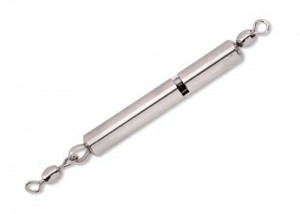
Trolling Rig for Sinker Release
Pro: Maintain good consistent depth and can get bait/lure down deep
Con: Expensive Gear, complex and tangles.
Brining Bait:
Brining bait is a method used to preserve and hardening bait for fishing. It is useful for preserve bait for multiple day fishing trips and increase the effectiveness and strike ratio. Salmon University: Brining Herring. A basic brine consist of salt, a whitening agent and powdered milk. The salt hardens the bait by drawing water from the fish into the brine. The whitening agent such as “Ms. Stewarts bluing Agent” shines the bait, and the powdered milk helps keeps the scales on the fish. This combo of salt and shine will keep the bait looking its best and ensuring a higher hook up ratio.
Check out Moomoo Outdoors brine video:
Sliding & Banana sinker set up
The sliding sinker set up is my preferred method for mooching and drifting, mainly because it offers flexibility to change out weight based on drifting and wind conditions. Banana sinkers work in the same fashion but without the flexibility. A banana weight set up is my friend loletaEric’s method for catching large salmon up north.
Kayak Salmon Fishing Tips
TIP: Sometimes salmon will nibble at a bait. When the fish do this it is important to “FEED” them (meaning give it some line). Nibbling salmon will not immediately take the bait but rather check it and tap it. Continue to “FEED” the bait until the rod tips loads up (meaning the fish has taken the bait), thus ensuring a solid hook set. This may sound counter intuitive but it works and is very effective.
Landing Salmon
Landing a wild salmon is one of the most challenging endeavors to undertake as a kayak fisherman. The erratic and unpredictable behavior of the salmon, combined with state regulations (Barbless Hooks) and the limited maneuverability of a kayak stacks the odds against any fisherman. Here are a few tips to even the odds:
TIPS:
- Manage Leaders – Keep leaders manageable, meaning, do not make leaders longer then is manageable. For me personally, my max length does not exceed 5 ft. (Salmon STS leaders , are great for salmon)
- Don’t High Stick the Fish!!! – High sticking fish is a sure way to lose a fish. This is something i have seen all too often and leads to pulling the hook out of the Salmon’s mouth. Keep the rod tip low but with tension. Slowly work the fish to the net when it goes belly up. Be steady even when the fish thrashes
- Keep the line tight – Keep tension on the line at all times. A salmon is just looking for a quick opportunity to shake the barbless hook. If you have a peddle kayak keep peddling and keep the salmon behind you at all times even if they charge forward.
- Bring a big net – Salmon are big fish so bring a BIG NET (BIG 5 trout nets will not cut it)
- Properly set the drag – Properly setting the right tension and drag on the line is important. Set the right tension and forget it. (Do not tighten or loosen the drag during a fight, doing so is asking to lose a fish!)
- Check the leaders and terminal tackle – This is simple. Just do it. There is no excuse not to. Knicks, tangles and breaks in terminal tackle is a quick path to a fast heartbreak.
- Keep the hooks sharp – Make sure the hook is sticky to the touch. Sharp hooks will ensure a solid hook set in the salmon jaw line when it hits.
- Match the hatch – Match what the salmon are feeding. If they are feeding on anchovies feed them anchovies.
- Land the fish when it is ready– Salmon sometimes come up “HOT”, especially when it is a surface bite. Net salmon when they are ready, and not before. Many new fisherman’s natural reaction is to land the fish as fast as possible to limit the possibility the fish will come off. The “real” mistake is landing the fish when it is not ready. When a salmon is “ready” it will make one last dash to save itself. This last ditch effort will drain its remaining energy making it much easier to land. Being calm is a byproduct of experience. Staying calm and in control will drastically increase your chances of landing big fish.
Conclusion:
Catching salmon from a kayak is one of the most rewarding and exhilarating fishing experiences on the north and central coast. Losing big fish on a kayak is part of the experience and accepting that truth will make you a better fisherman. Be patient, stay hungry and take things in stride. There will always be more salmon. Good luck and tight lines.
The Lost Anchovy
Version: 2.2
Updated 6.28.2019
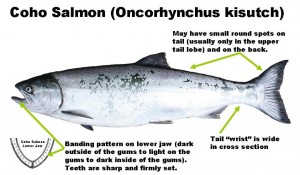
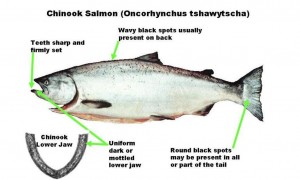
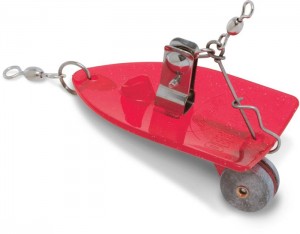
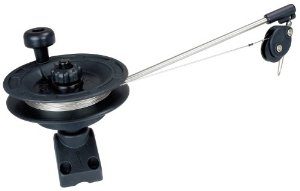
What is the ‘right tension’?
Hi I just had a question about netting a fish in peddle drive kayak.. when fish is already tired should I keep peddling while netting. Or can I stop peddling and swing em in the net??? -Ron C.
My personal preference that has worked for me is that i peddle towards the fish and scope them up rather than add pressure to the line and pull them towards me. I’ve pulled way too many salmon hooks out in the past. That is what i do.
Hi Lost Anchovy! Is the Lake Troller your preferred downrigger? I’m looking to get my first one and see there is also a “depthmaster.” Thanks!
Hi Matt,
There are a few options when it comes to downriggers, but I prefer the lake troller, for its simplicity and being compact. I use a Hobie Revo, because i don’t have much deck space. However i have seen other use the depthmaster with larger kayaks such as the AI, or even an outback with great success. Most of salmon i catch do not go deeper than 70 ft so the lake troller works for me. I hope that helps you. –TLA
Any tips on fishing the Raccoon Straits/Angel Island area?
Hi Ron,
I’ve actually never fished the racoon straights, and the Angel Island Area. I know that a lot guys use silvertrons when the Salmon enter the delta,
but that is as much as i know. If you find anything, let me know and I would love to add it to the tutorial. –TLA
Thanks for the tips…got my first salmon off my kayak yesterday at HMB. Really appreciate your sharing of your valuable knowledge!
That’s awesome steve! Glad you got them. It only gets easier over the years.
Nice article. Thank you.